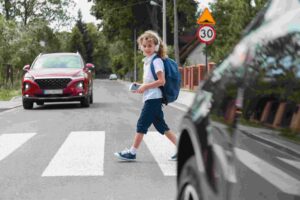
At Nelson Personal Injury, LLC, we specialize in representing individuals injured in pedestrian accidents throughout Minnesota. We understand the physical, emotional, and financial toll being injured in an accident can take on individuals and families and we are here to help you secure the compensation you deserve.
If you have been injured as a pedestrian, contact our office to schedule a free consultation.
Pedestrian Accident Statistics in Minnesota
According to the Minnesota Department of Public Safety, pedestrian accidents account for a significant portion of traffic-related fatalities and injuries in the state. In 2020, there were 41 pedestrian fatalities and 954 injuries, representing a concerning increase from previous years.

Millions Recovered for Minnesota Accident Injury Victims.
Get a case evaluation today for FREE.
No Recovery, No Fee.
While these statistics are alarming, it is crucial to understand the laws in place to protect pedestrians and how our experienced attorneys can help you seek justice if you have been injured as a pedestrian.
Minnesota Laws to Protect Pedestrians
Minnesota has laws designed to protect pedestrians, ensuring their safety as they navigate the roads alongside motor vehicles. Some of these laws include:
- Minnesota Statute 169.21, which outlines the rights and responsibilities of pedestrians on roadways.
- The “crosswalk law” (Minnesota Statute 169.21, Subdivision 2) requires drivers to stop and yield the right-of-way to a pedestrian crossing within a marked or unmarked crosswalk at an intersection.
- The “sidewalk law” (Minnesota Statute 169.34) prohibits drivers from blocking or parking on sidewalks, ensuring pedestrians have a safe walking space.
Pedestrians also have a responsibility to follow specific rules to maintain their safety. For example, Minnesota law requires pedestrians to obey traffic signals, use sidewalks when available, and yield the right-of-way to vehicles outside crosswalks.
Common Causes of Pedestrian Accidents
Pedestrian accidents can occur for wide variety of reasons, with some of the most common causes being:
Distracted Driving
Distracted driving is a dangerous behavior that poses a significant risk to pedestrians, motorists, and cyclists alike. It occurs when drivers engage in activities that divert their attention from driving, reducing their ability to react to potential hazards and make safe decisions on the road.
There are three primary types of distractions: visual (taking your eyes off the road), manual (taking your hands off the wheel), and cognitive (taking your mind and attention off driving). Common examples of distracted driving include texting or talking on the phone, adjusting the radio, eating, grooming, or engaging with passengers. Among these, texting while driving is considered the most hazardous, as it involves all three distractions.
According to the National Highway Traffic Safety Administration (NHTSA), distracted driving claimed 3,142 lives in the United States in 2019. To combat this growing problem, many states, including Minnesota, have implemented strict laws prohibiting activities like texting while driving or using any sort of electronic device while operating your vehicle.
In addition to obeying these laws, drivers should stay focused on the road, avoid multitasking, and prioritize safety over convenience to help reduce the prevalence of distracted driving-related accidents.
Failure to Yield
Failure to yield significantly contributes to pedestrian accidents and collisions between vehicles. This type of traffic violation occurs when a driver neglects to give the right-of-way to another vehicle or pedestrian when required by law. This failure can result in severe accidents, injuries, and even fatalities.
Examples include not stopping at a stop sign, failing to yield to oncoming traffic when turning left, or not yielding to pedestrians at intersections or in marked or unmarked crosswalks. These situations often arise due to drivers being inattentive, aggressive, or unfamiliar with traffic laws.
In Minnesota, the “crosswalk law” (Minnesota Statute 169.21, Subdivision 2) mandates that drivers must stop and yield the right-of-way to pedestrians crossing within a marked or unmarked crosswalk at an intersection. Drivers should always be vigilant, especially in areas with high pedestrian traffic, such as school zones or shopping centers.
To reduce the likelihood of accidents due to failure to yield, drivers should familiarize themselves with traffic laws, be attentive and patient, and prioritize the safety of all road users.
Additionally, pedestrians can take their safety into their own hands by making themselves visible to drivers and ensuring they have a clear path before crossing a road or street, even at a designated crosswalk.
Speeding
Speeding is a dangerous driving behavior that significantly increases the risk of accidents, injuries, and fatalities. When drivers exceed the posted speed limits or drive too fast for the prevailing road and weather conditions, they reduce their reaction time, making avoiding potential hazards and responding to changing traffic conditions more challenging.
According to the National Highway Traffic Safety Administration (NHTSA), speeding contributed to 26% of all traffic fatalities in 2019. The consequences of speeding are particularly severe for pedestrians, as higher speeds increase the likelihood of severe or fatal injuries in the event of a collision.
Speed limits are established to ensure the safety of all road users, including pedestrians, cyclists, and motorists. To prevent speeding-related accidents, drivers should adhere to posted speed limits, adjust their speed based on traffic flow and weather conditions, and remain vigilant for potential hazards.
Moreover, public awareness campaigns, traffic enforcement measures, and the implementation of traffic slowing strategies, such as speed bumps and roundabouts, can help encourage responsible driving behavior and reduce the prevalence of speeding. By prioritizing safety and adhering to established speed limits, drivers can contribute to safer roads for everyone.
Intoxicated Driving
Intoxicated driving, also known as driving under the influence (DUI) or driving while impaired (DWI), is a dangerous and illegal behavior that poses a significant threat to the safety of all road users. Intoxication impairs a driver’s cognitive and motor skills, including judgment, reaction time, coordination, and concentration, increasing the likelihood of accidents, injuries, and fatalities.
Alcohol and drugs, both illicit and prescription, can result in intoxicated driving. According to the National Highway Traffic Safety Administration (NHTSA), nearly 30 people die in the United States daily in alcohol-impaired vehicle crashes, equating to one person every 50 minutes.
To combat intoxicated driving, states have established strict laws and penalties, including fines, license suspensions, and imprisonment.
In Minnesota, the legal blood alcohol concentration (BAC) limit for drivers is 0.08% for adults and 0.04% for commercial vehicle drivers. For drivers under 21, any detectable amount of alcohol is illegal.
Preventing intoxicated driving begins with individual responsibility. Drivers should plan by designating a sober driver, using public transportation, or utilizing rideshare services if they plan to consume alcohol or take impairing medications.
Poor Visibility
Poor visibility is a significant contributing factor to accidents on the road, as it makes it more challenging for drivers to perceive and react to potential hazards. Poor visibility can result from various factors, including inclement weather conditions, inadequate lighting, and obstructions to a driver’s line of sight.
Weather conditions such as fog, rain, snow, or dust can significantly reduce visibility, making it difficult for drivers to see other vehicles, pedestrians, or obstacles on the road. Inadequate lighting, whether due to insufficient streetlights or malfunctioning vehicle headlights, also contributes to poor visibility and increases the risk of accidents, especially during nighttime driving. Obstructions, such as overgrown foliage or large vehicles blocking a driver’s view, can create blind spots and limit visibility.
To minimize the risk of accidents due to poor visibility, drivers should:
- Adjust their speed and following distance to match the prevailing conditions;.
- Ensure their vehicle’s headlights, taillights, and turn signals are clean and in proper working order;.
- Use fog lights or low-beam headlights in foggy conditions to avoid glare; and.
- Be cautious in areas where pedestrians and cyclists are likely present, such as school zones or residential neighborhoods.
Additionally, local authorities can improve visibility by installing adequate street lighting, maintaining clear lines of sight at intersections, and implementing proper signage to alert drivers of potential hazards or changes in road conditions.
Common Injuries Sustained in Pedestrian Accidents
Pedestrian accidents often result in severe injuries, given the vulnerability of pedestrians compared to the size and weight of motor vehicles. Common injuries sustained in pedestrian accidents include:
- Traumatic brain injuries;
- Spinal cord injuries;
- Broken or fractured bones;
- Internal injuries;
- Soft tissue injuries, such as sprains and strains;
- Lacerations and abrasions; and
- Psychological injuries, such as post-traumatic stress disorder (PTSD).
Steps to Take After a Pedestrian Accident
If you or a loved one has been involved in a pedestrian accident, taking the following steps can help protect your rights and strengthen your case:
- Seek medical attention: Your health should be your top priority. Even if your injuries seem minor, it is essential to see a medical professional, as some injuries may not be immediately apparent.
- Gather evidence: If possible, take photos of the accident scene, your injuries, and any property damage. Collect contact information from witnesses and the driver involved.
- Report the accident: Contact the police and file an accident report. This document can be crucial when pursuing a personal injury claim.
- Keep records: Document all medical treatments, expenses, and any time missed from work due to the accident.
- Contact a pedestrian accident lawyer: An experienced attorney can help you navigate the complex legal process and protect your rights.
How Nelson Personal Injury, LLC Can Help
At Nelson Personal Injury, LLC, our team of dedicated attorneys understands the devastating impact pedestrian accidents can have on your life. We are committed to fighting for your rights and securing the compensation you deserve. Our legal team will work tirelessly to investigate your case, gather evidence, negotiate with insurance companies, and represent you in court if necessary.
FAQs
Q: How long do I have to file a personal injury claim after a pedestrian accident in Minnesota?
A: In Minnesota, the statute of limitations for personal injury claims based on negligence is generally six years from the accident date. However, other types of cases may have shorter statute of limitations time periods, so contacting an attorney as soon as possible is essential to ensure your rights are protected.
Q: What compensation can I seek in a pedestrian accident case?
A: Compensation may include past and future medical expenses, past and future lost wages, pain and suffering, emotional distress, and other damages related to the accident. Each case is unique, and our attorneys will work to maximize your recovery.
Q: What if the driver who hit me was uninsured or underinsured?
A: If the at-fault driver does not have adequate insurance coverage, your uninsured/underinsured motorist coverage may compensate for your injuries. Our attorneys can help you navigate this process and ensure you receive your deserved compensation.
Q: What if I was partially at fault for the accident?
A: Minnesota follows a comparative fault system, meaning that even if you are partially responsible for the accident, you may still be able to recover compensation. However, your compensation may be reduced by your percentage of fault.
Q: How much does it cost to hire a pedestrian accident lawyer?
A: At Nelson Personal Injury, LLC, we work on a contingency fee basis, meaning you pay nothing upfront and only pay if we successfully recover compensation on your behalf. If there is no recovery on your behalf, there are no attorney’s fees.
Q: Do I need a lawyer if the insurance company has already offered me a settlement?
A: It is essential to consult with an experienced pedestrian accident attorney before accepting any settlement offers. Insurance companies often try to minimize payouts, and an experienced attorney can help ensure you receive the full compensation you deserve.
Q: How long will it take to resolve my pedestrian accident case?
A: The timeline for resolving a pedestrian accident case can vary depending on the case’s complexity, the applicable insurance policy limits available, and the parties’ willingness to settle. Our attorneys will work diligently to resolve your case as quickly as possible while ensuring your rights are protected and you receive the compensation you deserve.
Contact Us Today for Help with Your Pedestrian Accident Claim
If you or a loved one has been injured in a pedestrian accident in Minnesota, let the experienced attorneys at Nelson Personal Injury, LLC fight for you.
Call us today at 320-216-7651 or contact us online using our free and secure submission form. We are available 24/7 to assist you and offer FREE initial consultations.



